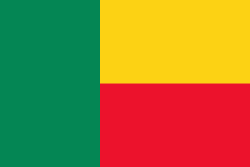Plateau Department (Plateau Department)
Plateau is one of the twelve departments of Benin. The department of Plateau was created in 1999 with an area of 2835 sqkm when it was split off from Ouémé Department. Plateau is subdivided into five communes, each centred at one of the principal towns: Adja-Ouèrè, Ifangni, Kétou, Pobè and Sakété.
, the total population of the department was 622,372, with 300,065 males and 322,307 females. The proportion of women was 51.80%. The total rural population was 54.80%, while the urban population was 45.20%. The total labour force in the department was 185,815, of which 43.10% were women. The proportion of households with no level of education was 65.50%.
Plateau Department border Collines Department to the north, Nigeria to the east, Ouémé Department to the southwest, and Zou Department to the west. It is characterised by plateaus ranging from 20 to 200 m above the mean sea level. The plateaus are split by valleys running from north to south, created by the Iguidi river. The river deposits of clay have rich iron ore deposits underneath; there is siliceous clay and forested area around the river basin. The southern regions of Benin receive two spells of rain from March to July and September to November, while the northern regions of the country receive one season of rainfall from May to September. The country receives an average annual rainfall of around 1200 mm.
, the total population of the department was 622,372, with 300,065 males and 322,307 females. The proportion of women was 51.80%. The total rural population was 54.80%, while the urban population was 45.20%. The total labour force in the department was 185,815, of which 43.10% were women. The proportion of households with no level of education was 65.50%.
Plateau Department border Collines Department to the north, Nigeria to the east, Ouémé Department to the southwest, and Zou Department to the west. It is characterised by plateaus ranging from 20 to 200 m above the mean sea level. The plateaus are split by valleys running from north to south, created by the Iguidi river. The river deposits of clay have rich iron ore deposits underneath; there is siliceous clay and forested area around the river basin. The southern regions of Benin receive two spells of rain from March to July and September to November, while the northern regions of the country receive one season of rainfall from May to September. The country receives an average annual rainfall of around 1200 mm.
Map - Plateau Department (Plateau Department)
Map
Country - Benin
 |
 |
| Flag of Benin | |
From the 17th to the 19th century, political entities in the area included the Kingdom of Dahomey, the city-state of Porto-Novo, and other states to the north. This region was referred to as the Slave Coast from the early 17th century due to the high number of people who were sold and trafficked during the Atlantic slave trade to the New World. France took over the territory in 1894, incorporating it into French West Africa as French Dahomey. In 1960, Dahomey gained full independence from France. As a sovereign state, Benin has had democratic governments, military coups, and military governments. A self-described Marxist–Leninist state called the People's Republic of Benin existed between 1975 and 1990. In 1991, it was replaced by the multi-party Republic of Benin.
Currency / Language
| ISO | Currency | Symbol | Significant figures |
|---|---|---|---|
| XOF | West African CFA franc | Fr | 0 |
| ISO | Language |
|---|---|
| FR | French language |















